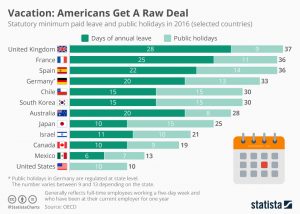Madrid is a peculiar place in August. Aside from the stifling heat, the traffic isn’t too hectic, restaurants are either closed or distinctly emptier while tourist hotspots are unusually quieter. That sense of tranquility is due to the locals leaving the Spanish capital in order to find refuge from the scorching temperatures in the countryside and along the coast. Spanish workers have no problems leaving their jobs for weeks on end given that they have a statutory minimum of 22 paid vacation days, according to the OECD. They get 14 public holidays on top of that, meaning they get a grand total of 36 paid days leave annually. Many workers get even days depending on their company and position.
The situation in France is similar, with motorways clogged with traffic every August as people flee the cities to start their summer holidays. French workers also get a minimum of 36 paid days off every year, of which 11 are public holidays and 25 are the statutory minimum. Elsewhere the vacation allowance falls in Asia’s major economies with South Korean workers getting a minimum of 15 days and people in Japan getting a mere 10.
That’s still far better than workers in the United States. While people in France and Spain spend weeks chilling at the beach, most Americans are more than likely still stuck at their desks. The U.S. remains the only advanced economy that doesn’t guarantee paid vacation. Even though some companies are generous and provide their employees with up to 15 days of paid leave annually, almost one in four private sector workers does not receive any paid vacation, according to the Center for Economic and Policy Research.
source: statista

Ask me anything
Explore related questions





